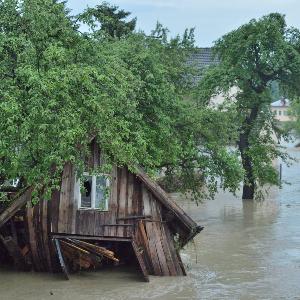New study findings could help improve flood forecasts
27 Aug 2021
An international research team has investigated the connection between heavy rainfall and flooding in elaborate simulations.
27 Aug 2021
An international research team has investigated the connection between heavy rainfall and flooding in elaborate simulations.

Copyright: IMAGO / argum / ThomasxEinberger
Climate change will lead to more and stronger floods, mainly due to an increase in the incidence of very heavy rainfall. In order to assess how flood risk and the severity of floods will change over time, it is particularly helpful to consider two different types of such extreme precipitation events: weaker and stronger ones. An international group of scientists led by Dr. Manuela Brunner of the Institute of Earth and Environmental Sciences at the University of Freiburg and LMU’s Prof. Dr. Ralf Ludwig has now shed light on this issue, which has been little studied to date.
They found that the weaker and more frequent class of extreme precipitation events (on average every 2 to 10 years) is increasing in frequency and intensity, but these events do not necessarily lead to flooding. In some places, climate change may even reduce the risk of flooding, owing to drier soils. Similarly, the more severe (and less frequent) extreme precipitation events (on average less than one in 50 years, such as that which occurred in the Eifel in July 2021) are increasing in frequency and severity, but they also generally lead to more frequent flooding.
“During stronger and less common extreme precipitation events, the amount of rain that reaches the ground is so large that the initial condition of the land surface has little influence on whether or not flooding will occur,” explains Manuela Brunner. “Its capacity to absorb water is exhausted relatively quickly, and from then on the rain runs off over the surface, thus flooding the landscape. In the case of weaker and more frequent extreme precipitation events, the outcome crucially depends on the prevailing soil conditions,” she says. “If the soil is dry, it can absorb a lot of water and the risk of flooding is low. However, if soil moisture is already high, flooding can occur here as well.” So, as climate change causes many soils to become drier, flood risk may decrease for the weaker, more frequent extreme precipitation events – but not for the rare and even more severe ones.
In the specific case of Bavaria, the scientists also predict that both types of extreme precipitation events will become more numerous. Weaker precipitation events, which occurred on average once every 50 years from 1961 to 2000, will occur twice as often in the period from 2060 to 2099. Stronger ones, which occurred on average about once every 200 years from 1961 to 2000, will become up to four times more frequent in the future.
“Previous studies have demonstrated that precipitation will increase due to climate change, but the correlation between flood intensities and more severe precipitation events has not yet been sufficiently investigated. That's where we started,” explains Manuela Brunner. “With the help of our unique dataset, this study provides an important building block for an urgently needed, better understanding of the very complex relationship between heavy precipitation and runoff extremes,” Ralf Ludwig adds. “This could also help to improve flood forecasts.”
In its analysis, the team identified so-called frequency thresholds in the relationship between future precipitation increase and flood rise for the majority of the 78 headwater catchments studied in the region around the rivers Inn, Danube and Main. These site-specific values describe which types of extreme precipitation events, classified by their frequency, are also likely to lead to devastating floods, such as the one that occurred in July in the Eifel region.
For the first time, the research team generated a large dataset by coupling hydrological simulations for Bavaria with a large ensemble of simulations based on a climate model. The model was applied to historical (1961-2000) and warmer future (2060-2099) climate conditions for the 78 river basins. “The region around the headwater catchments of the Inn, Danube, and Main rivers is an area with pronounced hydrological heterogeneity. As a result, we consider a wide variety of hydroclimates, soil types, land-use practices and runoff pathways in our study,” says Brunner.
In addition to Brunner and Ludwig, other researchers from LMU, the US National Center for Atmospheric Research and the University of California in Los Angeles collaborated on the project.
Brunner, M. I., Swain, D. L., Wood, R.R., Willkofer, F., Done, J.M., Gilleland, E., Ludwig, R. (2021): An extremeness threshold determines the regional response of floods to changes in rainfall extremes. In: Communications Earth & Environment 2021